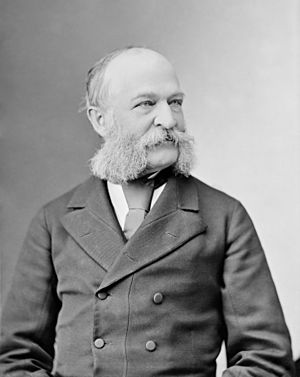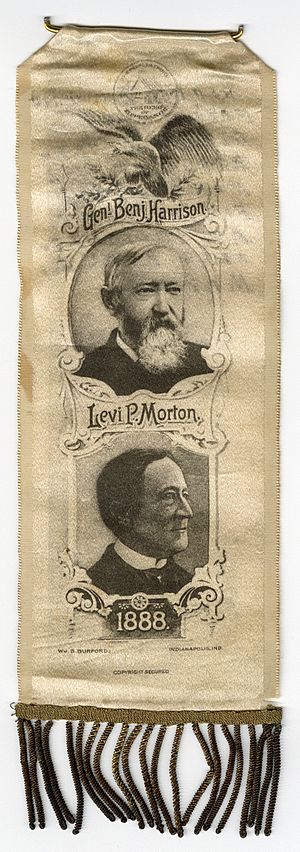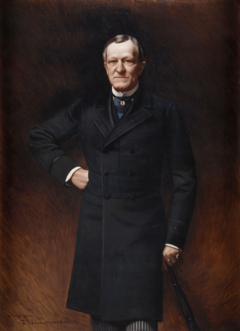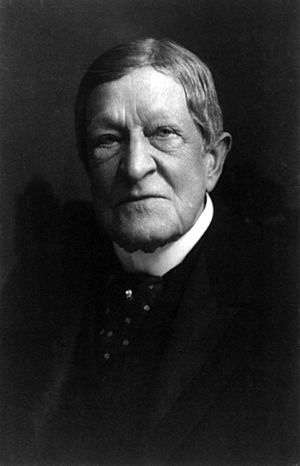Levi P. Morton facts for kids
Quick facts for kids
Levi P. Morton
|
|
|---|---|
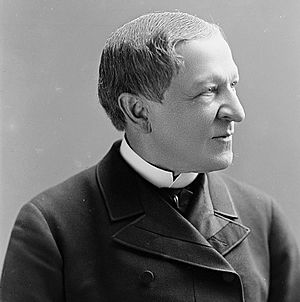
Photo by C. M. Bell (Washington, D.C.), c. 1885
|
|
| 22nd Vice President of the United States | |
| In office March 4, 1889 – March 4, 1893 |
|
| President | Benjamin Harrison |
| Preceded by | Thomas A. Hendricks |
| Succeeded by | Adlai Stevenson I |
| 31st Governor of New York | |
| In office January 1, 1895 – December 31, 1896 |
|
| Lieutenant | Charles T. Saxton |
| Preceded by | Roswell P. Flower |
| Succeeded by | Frank S. Black |
| United States Minister to France | |
| In office August 5, 1881 – May 14, 1885 |
|
| President | James A. Garfield Chester Arthur Grover Cleveland |
| Preceded by | Edward Follansbee Noyes |
| Succeeded by | Robert Milligan McLane |
| Member of the U.S. House of Representatives from New York's 11th district |
|
| In office March 4, 1879 – March 21, 1881 |
|
| Preceded by | Benjamin A. Willis |
| Succeeded by | Roswell P. Flower |
| Personal details | |
| Born |
Levi Parsons Morton
May 16, 1824 Shoreham, Vermont, U.S. |
| Died | May 16, 1920 (aged 96) Rhinebeck, New York, U.S. |
| Resting place | Rhinebeck Cemetery, Rhinebeck, New York, U.S. |
| Political party | Republican |
| Spouses |
Lucy Young Kimball
(m. 1856; Anna Livingston Reade Street
(m. 1873; |
| Relations | Daniel O. Morton (brother) William Morton Grinnell (nephew) |
| Children | 7 |
| Parents | Daniel Oliver Morton Lucretia Parsons Morton |
| Profession | Investment banker |
| Signature |  |
Levi Parsons Morton (May 16, 1824 – May 16, 1920) was an important American politician and businessman. He served as the 22nd Vice President of the United States from 1889 to 1893. Before that, he was the United States Ambassador to France. He also represented New York State in the United States House of Representatives. Later, he became the 31st Governor of New York.
Morton was born in Vermont. His father was a minister. He went to public schools in Vermont and Massachusetts. He learned about business by working in stores. He worked in Massachusetts and New Hampshire. Later, he moved to New York City. There, he became a very successful merchant and banker.
Morton was a Republican. He was elected to the United States House of Representatives twice. He served from 1879 to 1881. In 1880, he was offered the chance to be the vice presidential candidate. He turned it down.
After that, President James A. Garfield made Morton the Minister to France. He served in Paris until 1885. In 1888, Morton became the vice presidential candidate with Benjamin Harrison. They won the election. Morton was Vice President from 1889 to 1893. In 1894, he was elected governor of New York. He served one term, from 1895 to 1896.
After his time as governor, Morton retired. He lived in New York City and Rhinebeck, New York. He died on his 96th birthday in 1920. He was buried in Rhinebeck Cemetery.
Contents
Early Life and Education
Levi Morton was born in Shoreham, Vermont, on May 16, 1824. He was one of six children. His father, Daniel Oliver Morton, was a Congregational minister. His mother was Lucretia Parsons. Morton's family came from England. His ancestors were early settlers in New England.
His family moved to Springfield, Vermont, in 1832. His father became a minister there. Levi was known as a leader among his school friends. The family later moved to Winchendon, Massachusetts. In 1838, Levi Morton finished his studies at the academy in Shoreham, Vermont.
A Career in Business
Morton decided to work in business. In 1838, he started as a clerk in a store in Enfield, Massachusetts. He also taught school in Boscawen, New Hampshire. He worked in business in Hanover, New Hampshire. Then he moved to Boston to work in an importing company.
He finally settled in New York City. There, he started a successful business buying and selling cotton. He then became a top investment banker. He founded his own company, Morton, Bliss & Co. This company later became the Morton Trust Company.
During the American Civil War, Morton supported the Union. He stopped his cotton business because of the war. After the war, his bank helped the United States and England settle a financial dispute. Morton's bank was chosen to handle payments to people in the U.S.
Morton was also involved in many other businesses. He was on the board of directors for several companies. These included railway, insurance, and trust companies. He also invested in many projects. In 1909, his company merged with J. P. Morgan's company. After this, Morton retired from most of his business work.
Political and Civic Involvement
Early Political Steps
Morton was active in the Republican Party. In 1876, he became the finance chairman for the Republican National Committee. He also ran for Congress in 1876 but did not win. President Rutherford B. Hayes appointed him as an honorary commissioner for the Paris Exhibition of 1878.
Community Leadership
Morton cared about his community. He supported many civic and charity groups. In 1883, he helped start the Metropolitan Opera. In 1886, he joined the board of trustees for Hobart and William Smith Colleges. He also served on the board for the American Museum of Natural History.
Serving in Congress
In 1878, Morton was elected to the United States House of Representatives. He represented Manhattan. He was reelected in 1880. He served in Congress from March 4, 1879, until March 21, 1881. While in the House, he was part of the Foreign Relations Committee. He believed the U.S. currency should be based on the gold standard.
In 1880, James A. Garfield was the Republican choice for president. Garfield offered Morton the vice presidential spot. Morton turned it down. Garfield then offered it to Chester A. Arthur, who accepted. Garfield and Arthur won the election.
Ambassador to France
After the 1880 election, President Garfield appointed Morton as Minister to France. Morton accepted this role. He served from 1881 to 1885. He continued in office after Garfield died and Arthur became president.
Morton was very well-liked in France. He helped improve trade between the two countries. On October 24, 1881, he placed the first rivet in the Statue of Liberty during its construction in Paris. When the statue was finished, he officially accepted it for the United States. This happened in a ceremony on July 4, 1884.
Vice Presidency (1889–1893)

At the 1888 Republican National Convention, Benjamin Harrison was chosen as the presidential candidate. Morton was then nominated for vice president. He won the nomination on the first try.
In the general election, Harrison and Morton won the election. They took office on March 4, 1889. They served until March 4, 1893.
Harrison's wife, Caroline Harrison, was often sick. She died in 1892. As the Second Lady, Morton's wife, Anna Morton, often served as the official hostess for President Harrison. She performed the duties of the First Lady.
As Vice President, Morton was in charge of the U.S. Senate. President Harrison did not often ask Morton for advice. One important bill was the Lodge Bill. This bill aimed to protect the voting rights of African American men. Southern Democrats tried to stop the bill by talking for a very long time (a filibuster).
The Lodge Bill reached the Senate floor. Morton cast the deciding vote to allow it to be discussed. But the Democrats started another filibuster. Morton did not help Republicans end it. The bill eventually failed.
Harrison blamed Morton for the bill's failure. In 1892, Harrison was nominated for reelection. But the Republicans chose Whitelaw Reid instead of Morton as his running mate. Harrison and Reid lost the election to Grover Cleveland and Adlai Stevenson I.
After the Vice Presidency (1893–1920)
Governor of New York (1895-1896)
In 1894, Morton was elected governor of New York. He defeated David B. Hill. He served one two-year term, from January 1, 1895, to December 31, 1896. As governor, Morton helped combine several towns near New York City. This created the City of Greater New York in 1898.
Morton also supported civil service reform. This meant hiring people for government jobs based on their skills, not just their political connections. This put him against some political leaders. Because of this, the Republican Party nominated someone else for governor in 1896.
Morton was considered for the Republican presidential nomination in 1896. But the delegates chose William McKinley. After his term as governor, Morton went back to his business and investments.
Later Years and Legacy
In 1890, Morton joined the District of Columbia Society of the Sons of the American Revolution. He was also a member of the General Society of Colonial Wars. In retirement, he was president of the Metropolitan Club. He also led the New York Zoological Society from 1897 to 1909.
Morton became sick in late 1919. He got pneumonia, which led to his death. He died in Rhinebeck, New York, on May 16, 1920. It was his 96th birthday. After a service, he was buried at Rhinebeck Cemetery. At 96, Morton was the longest living Vice President of the United States for a time.
Personal Life and Family
On October 15, 1856, Morton married Lucy Young Kimball. They had one daughter, Carrie, who died as a baby. Lucy died in 1871.
In 1873, Morton married Anna Livingston Reade Street. They had five daughters and one son who died as a baby.
- Edith Livingston Morton (1874–1964)
- Lena Kearney Morton (1875–1904)
- Helen Stuyvesant Morton (1876–1952)
- Lewis Parsons Morton (1877–1878)
- Alice Morton (1879–1917)
- Mary Morton (1881–1932)
In 1902, Alice Morton started "Holiday Farm." This was a home for sick children to get better. Children came from New York City to the farm in Rhinebeck. Their travel, food, and clothes were all free. Holiday Farm later became the Astor Home for Children.
Honors and Recognition
In 1881, Dartmouth College gave Morton an honorary LL.D. degree. In 1882, Middlebury College also gave him an honorary LL.D.
The Mortons lived at an estate called Ellerslie near Rhinecliff, New York. Anna and Levi Morton built the Morton Memorial Library in Rhinecliff. They built it to remember their daughter Lena. It opened in 1908 and is now a historic site.
The village of Morton Grove, Illinois, was named after Morton. He helped fund a railway that expanded into Michigan and Wisconsin.
Morton spent summers in Newport, Rhode Island. He owned a large house called "Fairlawn." This home is now part of Salve Regina University. Morton also gave another property in Newport to the city for a park. It is called Morton Park.
In 1885, Morton bought land and a home in Hanover, New Hampshire. He gave it to Dartmouth College. He also set up scholarships at Dartmouth and Middlebury College.
Morton also owned a summer home on Eagle Island in Upper Saranac Lake. This home was designed in the "Great Camps" style. The Morton family later sold it. In 1938, it was given to the Girl Scouts. They used it as a summer camp for many years.
A statue of Morton is in the United States Senate Vice Presidential Bust Collection at the U.S. Capitol. It was made in 1891. A painting of Morton is in the New York State Hall of Governors.
See also
 In Spanish: Levi P. Morton para niños
In Spanish: Levi P. Morton para niños
- Place des États-Unis, Paris, France


